We are temporarily not accepting orders from Canada due to the Canada Post strike.
Nous n’acceptons temporairement pas de commandes en provenance du Canada en raison de la grève de Canada Post.
We are temporarily not accepting orders from Canada due to the Canada Post strike.
Nous n’acceptons temporairement pas de commandes en provenance du Canada en raison de la grève de Canada Post.

Abrol syrup 15 mg/5 ml in a 100 ml bottle
$16.01
Abrol (Ambroxol) relieves cough, improves mucus clearance & eases breathing. Available as tablets, syrup (15 mg/5 ml, 30 mg/5 ml) & SR capsules 75 mg.
Pharmacological properties
Pharmacodynamics. The active substance of the drug Abrol – ambroxol hydrochloride – increases the secretion of the glands of the respiratory tract. Ambroxol enhances the secretion of pulmonary surfactant by directly affecting type II pneumocytes in the alveoli and Clara cells in the bronchioles, and also stimulates ciliary activity. This contributes to an increase in mucus secretion and improvement of mucociliary clearance. Improvement of mucociliary clearance has been proven during clinical and pharmacological studies.
Activation of fluid secretion and increased mucociliary clearance facilitate mucus clearance and reduce coughing.
Ambroxol hydrochloride is known to have a local anesthetic effect, which may be due to its ability to block sodium channels. Blockade of neuronal sodium channels was characterized by the fact that binding was reversible and concentration-dependent.
Ambroxol hydrochloride has anti-inflammatory effects. In vitro studies have shown that ambroxol hydrochloride significantly reduces cytokine release from the blood and tissue binding of mononuclear and polymorphonuclear cells.
Clinical studies involving patients with pharyngitis have shown a significant reduction in pain and redness in the throat when using the drug. Also, during studies of the clinical efficacy of inhaled forms of ambroxol, it was demonstrated that ambroxol hydrochloride is effective in the treatment of the upper respiratory tract, as it contributes to the rapid reduction of pain and associated discomfort in the nasal cavity, ear and trachea during inhalation.
After the use of ambroxol hydrochloride, the concentrations of antibiotics (amoxicillin, cefuroxime, erythromycin) in bronchopulmonary secretions and sputum increase.
Pharmacokinetics. Absorption. Absorption of ambroxol hydrochloride from oral non-prolonged-release forms is rapid and fairly complete, with a linear relationship in the therapeutic range. C max in blood plasma is achieved after 1-2.5 hours with oral administration of rapid-release forms and on average after 6.5 hours with slow-release forms. The relative bioavailability of prolonged-release capsules is 95%.
Distribution. When administered orally, the distribution of ambroxol hydrochloride from the blood to the tissues is rapid and pronounced, with a high concentration of the active substance in the lungs. The volume of distribution when administered orally is 552 l. In the blood plasma in the therapeutic range, approximately 90% of the drug is bound to proteins.
Metabolism and excretion. About 30% of the dose after oral administration is excreted by presystemic metabolism. Ambroxol hydrochloride is metabolized in the liver by glucuronidation and cleavage to dibromantranilic acid (about 10% of the dose). It is known that in human liver microsomes CYP 3A4 is responsible for the metabolism of ambroxol hydrochloride to dibromantranilic acid.
After 3 days of oral administration, about 6% of the dose is excreted unchanged, while about 26% is excreted in the urine in conjugated form.
T ½ from plasma is about 10 hours. Total clearance is within 660 ml/min with renal clearance accounting for about 83% of total clearance.
Pharmacokinetics in special patient groups. In patients with impaired liver function, the excretion of ambroxol hydrochloride is reduced, which results in a 1.3-2 times higher level in the blood plasma. Since the therapeutic range of ambroxol hydrochloride is quite wide, no dose adjustment is required.
Age and gender do not have a clinically significant effect on the pharmacokinetics of ambroxol hydrochloride, therefore dose adjustment is not required.
Food intake does not affect the bioavailability of ambroxol hydrochloride.
Indication
Secretolytic therapy for acute and chronic bronchopulmonary diseases associated with disorders of bronchial secretion and impaired mucus movement.
Application
Abrol tablets. Unless otherwise prescribed, the recommended dose of Abrol tablets is as follows:
children aged 6-12 years: the dose is ½ tablet 2-3 times a day (equivalent to 30-45 mg of ambroxol hydrochloride per day);
Adults and children over 12 years of age: the dose is 1 tablet 3 times a day for the first 2-3 days (equivalent to 90 mg ambroxol hydrochloride per day). Continue treatment with 1 tablet 2 times a day (equivalent to 60 mg ambroxol hydrochloride per day).
If necessary, the therapeutic effect for adults and children over 12 years of age can be enhanced by taking 2 tablets 2 times a day (equivalent to 120 mg of ambroxol hydrochloride per day).
The tablets should be swallowed whole with sufficient liquid (e.g. water, tea or fruit juice) after meals.
In general, there are no restrictions on the duration of use, but long-term therapy should be carried out under medical supervision.
Abrol tablets should not be used for longer than 4-5 days without consulting a doctor.
Abrol syrup 15 mg / 5 ml. Unless otherwise prescribed, the recommended dose of Abrol syrup 15 mg / 5 ml is as follows:
children under 2 years of age: 2.5 ml (½ teaspoon) 2 times a day (equivalent to 15 mg of ambroxol hydrochloride per day);
children aged 2-6 years: 2.5 ml (½ teaspoon) 3 times a day (equivalent to 22.5 mg of ambroxol hydrochloride per day);
children aged 6-12 years: 5 ml (1 teaspoon) 2-3 times a day (equivalent to 30-45 mg of ambroxol hydrochloride per day);
Adults and children over 12 years of age: the dose is 10 ml (2 teaspoons) 3 times a day (equivalent to 90 mg of ambroxol hydrochloride per day) for the first 2-3 days and then 10 ml (2 teaspoons) 2 times a day (equivalent to 60 mg of ambroxol hydrochloride per day).
If necessary, the therapeutic effect for adults and children over 12 years of age can be enhanced by increasing the dose to 20 ml 2 times a day (equivalent to 120 mg of ambroxol hydrochloride per day).
For adults and children over 12 years of age, the use of a syrup with a higher concentration (Abrol syrup 30 mg / 5 ml) is recommended.
Abrol syrup 30 mg / 5 ml. Unless otherwise prescribed, the following regimen for taking Abrol syrup 30 mg / 5 ml is recommended:
children under 2 years of age: 1.25 ml 2 times a day (equivalent to 15 mg of ambroxol hydrochloride per day);
children aged 2-5 years: 1.25 ml 3 times a day (equivalent to 22.5 mg of ambroxol hydrochloride per day);
children aged 6-12 years: 2.5 ml up to 3 times a day (equivalent to 30-45 mg of ambroxol hydrochloride per day);
Adults and children over 12 years of age: the usual dose is 5 ml 3 times a day (equivalent to 90 mg ambroxol hydrochloride per day) for the first 2-3 days and then 5 ml 2 times a day (equivalent to 60 mg ambroxol hydrochloride per day).
If necessary, the therapeutic effect for adults and children over 12 years of age can be enhanced by increasing the dose to 10 ml 2 times a day (equivalent to 120 mg of ambroxol hydrochloride per day).
Abrol syrup can be used regardless of meals. The syrup can be measured using the measuring cup provided. Please note that the measuring cup is not intended for measuring a dose of 1.25 ml of syrup (for children aged 2-5 years). To measure a dose of 1.25 ml, you can use a plastic disposable syringe without a needle with a capacity of 2 ml.
There are basically no restrictions on the duration of use, but long-term therapy should be carried out under medical supervision.
Abrol syrup should not be used for longer than 4-5 days without consulting a doctor.
Abrol syrup can be used in patients with diabetes; 5 ml contains 1.2 g of carbohydrates.
Abrol syrup does not contain alcohol.
Abrol SR. Unless otherwise prescribed, the following dosage of Abrol SR is recommended:
Adults: 1 tablet once a day (equivalent to 75 mg/day of ambroxol hydrochloride) in the morning or evening after meals. The tablets should be swallowed whole with sufficient water.
In general, there are no restrictions on the duration of use, but long-term therapy should be carried out under medical supervision.
Abrol SR should not be used for longer than 4-5 days without consulting a doctor.
Children. Abrol tablets are prescribed for children over 6 years of age who cannot take syrup.
Abrol syrup can be used in pediatric practice. In children under 2 years of age, use as prescribed by a doctor.
Abrol SR is not used in pediatric practice.
Contraindication
The drug should not be used in patients with known hypersensitivity to ambroxol hydrochloride or to other components of the drug.
Abrol tablets are not intended for use in children under 6 years of age due to the strength of the action. Children under 6 years of age are recommended to use ambroxol in an appropriate dose.
Abrol SR is not intended for use in children and adolescents.
Side effects
Immune system, skin and subcutaneous tissue disorders: skin rash, urticaria, angioedema, pruritus, anaphylactic reactions (including anaphylactic shock), other hypersensitivity reactions, erythema, severe skin lesions: Stevens-Johnson syndrome and toxic epidermal necrolysis (Lyell’s syndrome).
From the nervous system: dysgeusia (taste disorder).
On the part of the digestive system: nausea, decreased sensitivity in the oral cavity, vomiting, diarrhea, dyspepsia, abdominal pain, dry mouth, constipation, drooling, dry throat.
On the part of the respiratory system, chest organs and mediastinum: decreased sensitivity in the pharynx, rhinorrhea, shortness of breath (as a symptom of a hypersensitivity reaction).
From the urinary system: dysuria.
General disorders: fever, mucous membrane reactions.
Special instructions
There have been only a few reports of severe skin lesions: Stevens-Johnson syndrome and toxic epidermal necrolysis (Lyell’s syndrome) – associated with the use of expectorants such as ambroxol hydrochloride. They could mainly be explained by the severity of the underlying disease in the patients and / or the simultaneous use of another drug. Also, in the initial stage of Stevens-Johnson syndrome or Lyell’s syndrome, patients may have non-specific flu-like symptoms such as fever, aches, rhinitis, cough and sore throat. Symptomatic treatment with cough and cold medications can be mistaken for such non-specific symptoms of the onset of influenza. Therefore, if new lesions of the skin or mucous membranes appear, medical help should be sought immediately and treatment with ambroxol hydrochloride should be discontinued.
In case of impaired bronchial motility and increased mucus secretion (for example, in a rare disease such as primary ciliary dyskinesia), the drug should be used with caution, since ambroxol may increase mucus secretion.
Patients with impaired renal function or severe hepatic insufficiency should take the drug only after consulting a doctor. When using ambroxol, as with any substance that is metabolized in the liver and then excreted by the kidneys, there is an accumulation of metabolites formed in the liver in patients with severe renal insufficiency.
Abrol syrup, 15 mg/ml and 30 mg/5 ml, contains 1.225 g of sorbitol per 5 ml (equivalent to 9.8 and 4.9 g respectively at the maximum daily dose). If you have been told by your doctor that you have an intolerance to some sugars, contact your doctor before taking this medicine.
Use during pregnancy or breastfeeding. Pregnancy. Ambroxol hydrochloride crosses the placental barrier. No harmful effects on the fetus have been identified when using the drug after the 28th week of pregnancy. However, the usual precautions should be taken when taking medications during pregnancy. The drug is not recommended for use in the first trimester of pregnancy.
Breastfeeding. Ambroxol hydrochloride passes into breast milk. The drug is not recommended for use during breastfeeding.
Ability to influence the reaction rate when driving vehicles or other mechanisms. There is no data on the effect on the ability to drive vehicles or other mechanisms. Studies have not been conducted.
Interactions
The simultaneous use of ambroxol and cough suppressants may lead to excessive mucus accumulation due to suppression of the cough reflex. Therefore, such a combination is possible only after a careful assessment by the doctor of the ratio of the expected benefit and the possible risk of use.
Overdose
At the moment, there are no reports of specific symptoms of overdose. Symptoms known from isolated reports of overdose and / or cases of mistaken use of medicines correspond to the known side effects of the drug at recommended doses and require symptomatic treatment.
Storage conditions
In the original packaging at a temperature not exceeding 25 °C in a place protected from light. After opening the bottle, the drug should be stored for no more than 4 weeks.

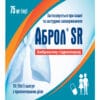
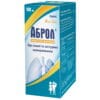
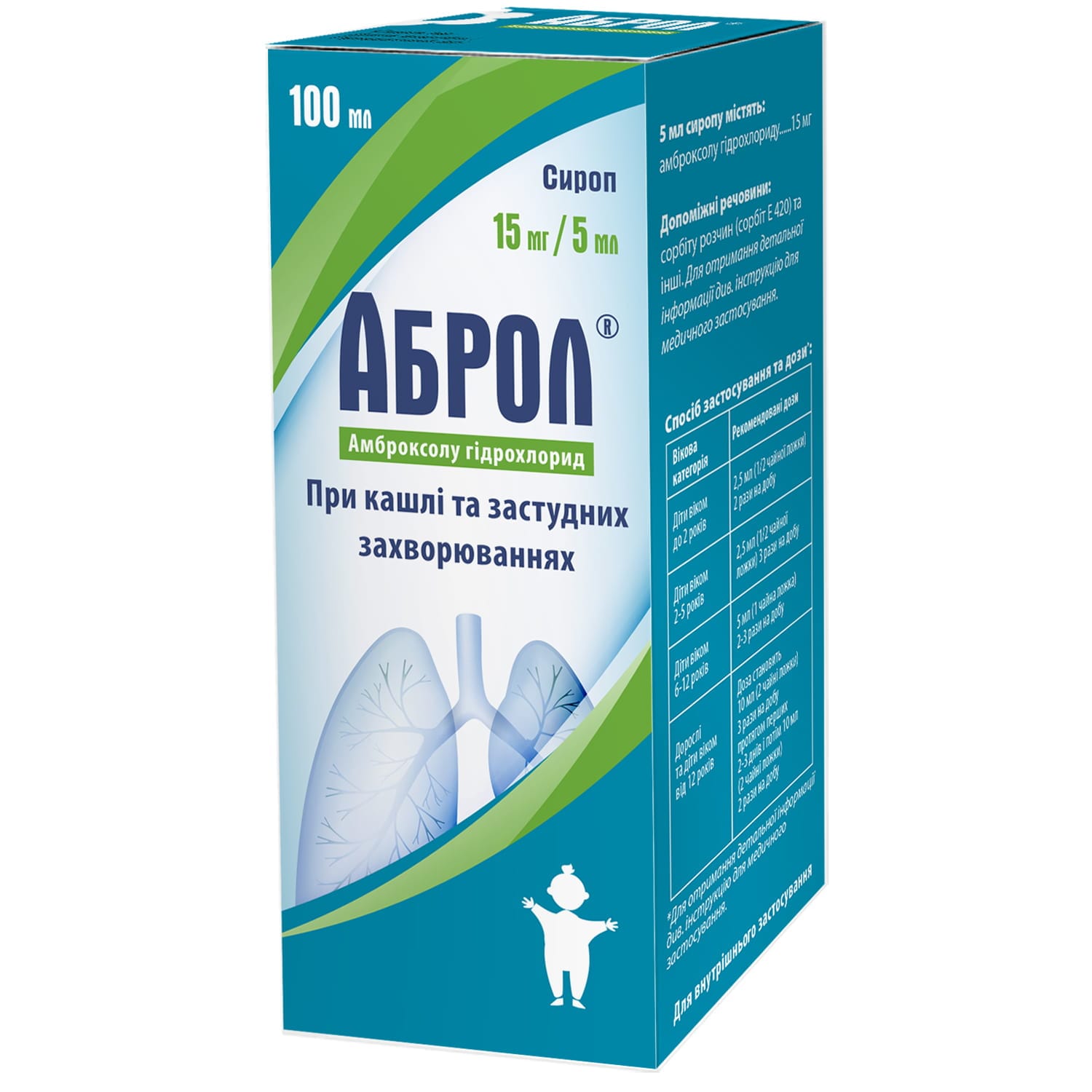
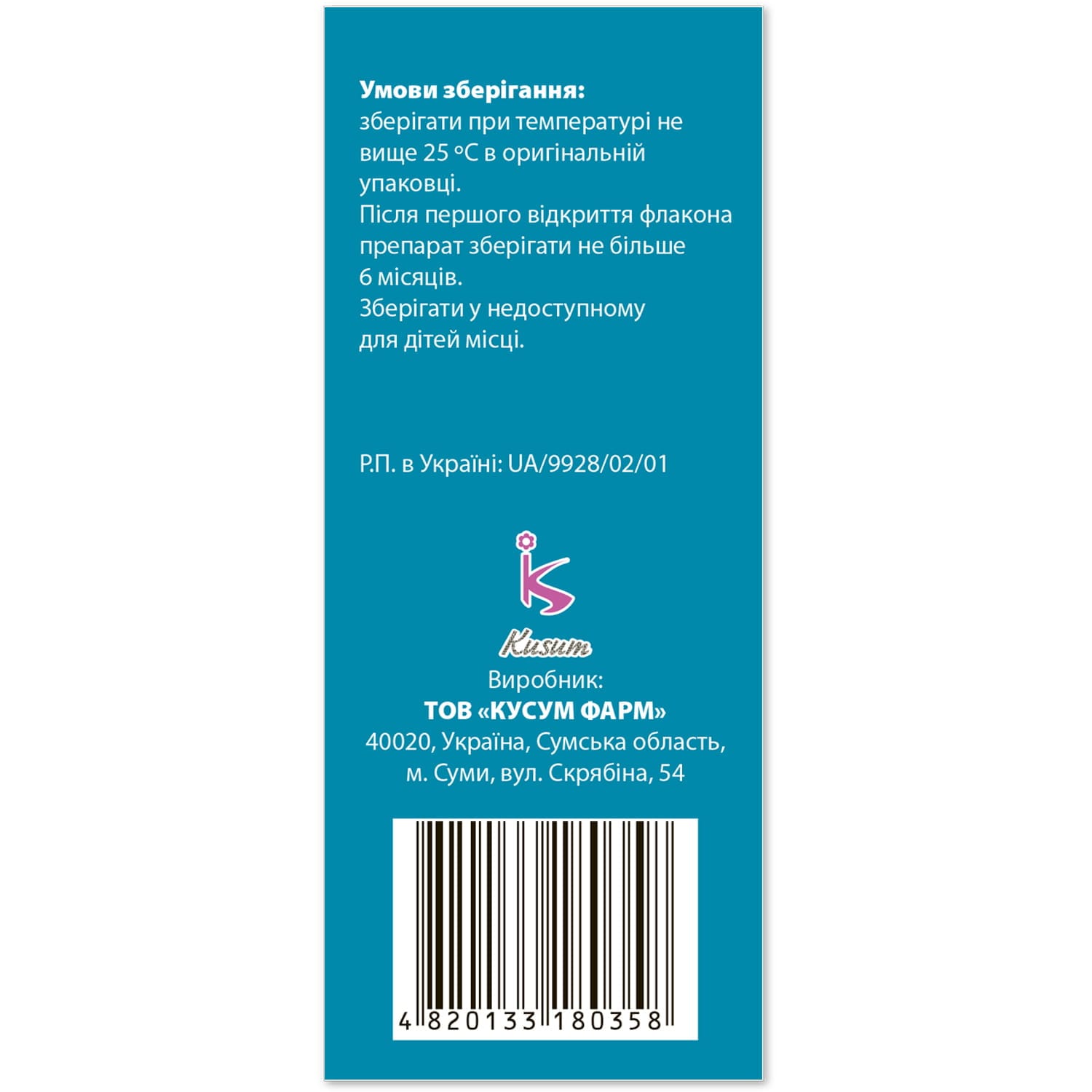
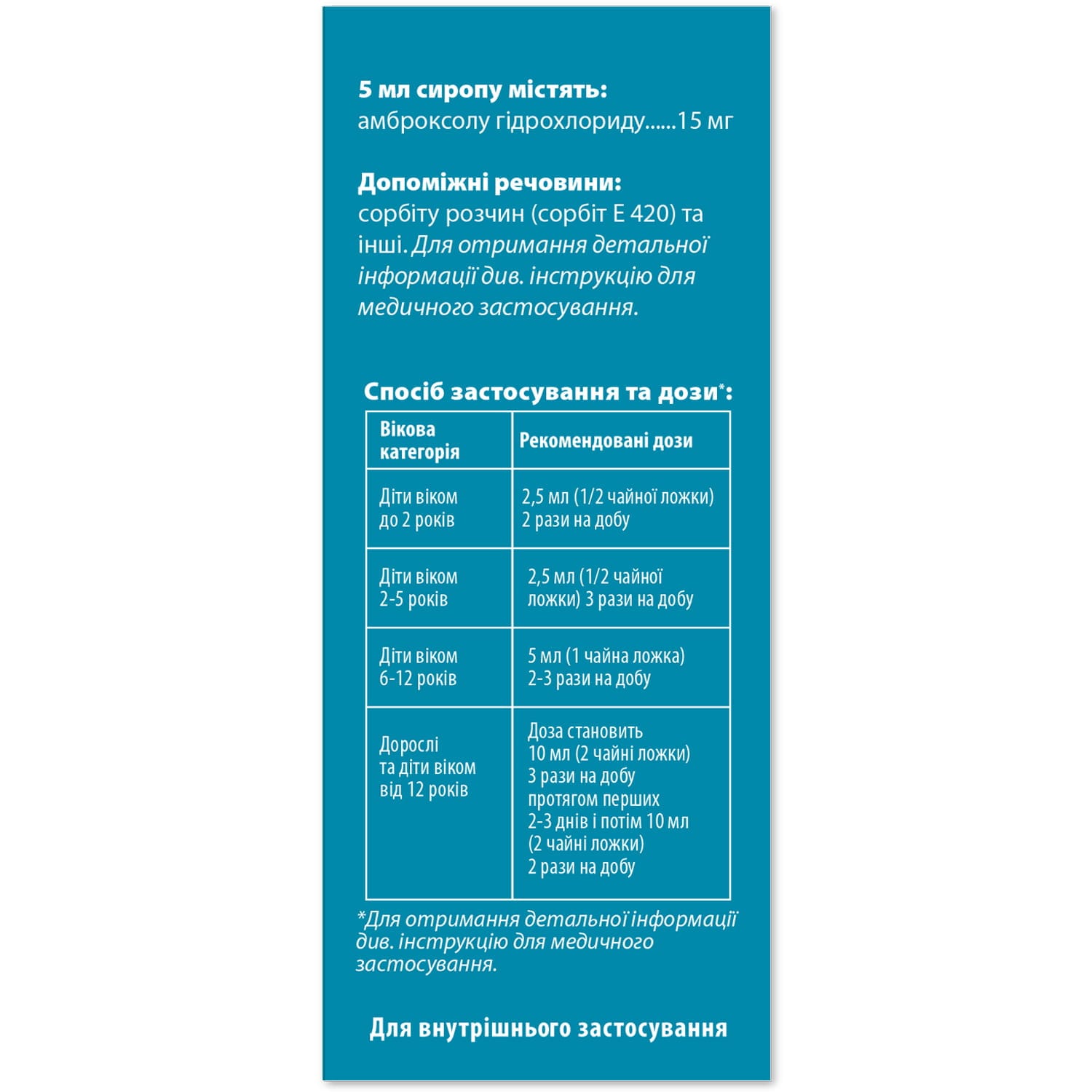

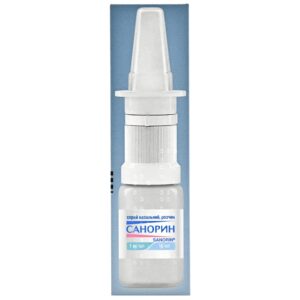
Reviews
There are no reviews yet.